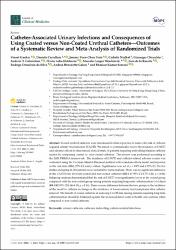Catheter-associated urinary infections and consequences of using coated versus non-coated urethral catheters-outcomes of a systematic review and meta-analysis of randomized trials

Göster/
Erişim
info:eu-repo/semantics/openAccessAttribution 4.0 Internationalhttps://creativecommons.org/licenses/by/4.0/Tarih
2022Yazar
Gauhar, VineetCastellani, Daniele
Teoh, Jeremy Yuen-Chun
Nedbal, Carlotta
Chiacchio, Giuseppe
Gabrielson, Andrew T.
Heldwein, Flavio Lobo
Wroclawski, Marcelo Langer
de la Rosette, Jean J. M. C. H.
Donalisio da Silva, Rodrigo
Galosi, Andrea Benedetto
Somani, Bhaskar Kumar
Üst veri
Tüm öğe kaydını gösterKünye
Gauhar, V., Castellani, D., Teoh, JYC., Nedbal, C., Chiacchio, G., Gabrielson, A. ... Somani, B. (2022). Catheter-associated urinary infections and consequences of using coated versus non-coated urethral catheters-outcomes of a systematic review and meta-analysis of randomized trials. Journal of Clınıcal Medicine, 11(15). https://doi.org/10.3390/jcm11154463Özet
Coated urethral catheters were introduced in clinical practice to reduce the risk of catheter-acquired urinary tract infection (CAUTI). We aimed to systematically review the incidence of CAUTI and adverse effects in randomized clinical trials of patients requiring indwelling bladder catheterization by comparing coated vs. non-coated catheters. This review was performed according to the 2020 PRISMA framework. The incidence of CAUTI and catheter-related adverse events was evaluated using the Cochran-Mantel-Haenszel method with a random-effects model and reported as the risk ratio (RR), 95% CI, and p-values. Significance was set at p < 0.05 and a 95% CI. Twelve studies including 36,783 patients were included for meta-analysis. There was no significant difference in the CAUTI rate between coated and non-coated catheters (RR 0.87 95% CI 0.75-1.00, p = 0.06). Subgroup analysis demonstrated that the risk of CAUTI was significantly lower in the coated group compared with the non-coated group among patients requiring long-term catheterization (>14 days) (RR 0.82 95% CI 0.68-0.99, p = 0.04). There was no difference between the two groups in the incidence of the need for catheter exchange or the incidence of lower urinary tract symptoms after catheter removal. The benefit of coated catheters in reducing CAUTI risk among patients requiring long-term catheterization should be balanced against the increased direct costs to health care systems when compared to non-coated catheters.
WoS Q Kategorisi
Q2Scopus Q Kategorisi
Q1Kaynak
Journal of Clinical MedicineCilt
11Sayı
15Koleksiyonlar
İlgili Öğeler
Başlık, yazar, küratör ve konuya göre gösterilen ilgili öğeler.
-
Near zero fluoroscopy radiation exposure during successful catheter ablation of atrial tachycardia from the non-coronary aortic cusp using 3-dimentional electroanatomic mapping system
Güler, Ekrem; Karaca, Oğuz; Kızılırmak, Filiz; Babür Güler, Gamze; Kılıçaslan, Fethi (AVES, 2014)Atrial tachycardia (AT) rarely originates from the paraHisian region (1). Catheter ablation of paraHisian AT carries a substantial risk of atrioventricular (AV) block. Cryoablation offers a safer ablation strategy for these ... -
Çocuklara anatomik tanımlama ve ultrasonografi eşliğinde perkütan santral venöz kateter takılması yöntemlerinin karşılaştırılması - Tek merkez deneyimi
Yıldız, Yahya; Ulukan, Mustafa Özer; Cantürk, Emir; Gül, Yaşar Gökhan; Erkanlı, Korhan; Demiraran, Yavuz; Uğurlucan, Murat; Türkoğlu, Halil (Göğüs Kalp Damar Anestezi ve Yoğun Bakım Derneği, 2019)Amaç: Pediyatrik kardiyak anestezist tarafından ultrasonun yaygın olarak kullanılması ile zaman ve malzeme tasarrufu ile birlikte başarılı girişim sayısı artmış, komplikasyonlarda da azalma olmuştur. Bu çalışmada, çocuklara ... -
Is the presence of left atrial diverticulum associated with recurrence in patients undergoing catheter ablation for atrial fibrillation?
Demir, Gültekin Günhan; Güneş, Hacı Murat; Şeker, Mehmet; Savur, Ümeyr; Babur Güler, Gamze; Güler, Ekrem; Doğan, Mehmet; Erol, Cengiz; Kılıçaslan, Fethi (2019)INTRODUCTION: Catheter ablation (CA) for atrial fibrillation (AF) has been a major cornerstone in the management of AF. Despite promising advances in CA techniques, long-term results reveal a high rate of recurrence after ...


















